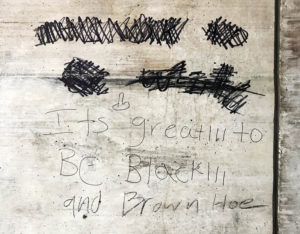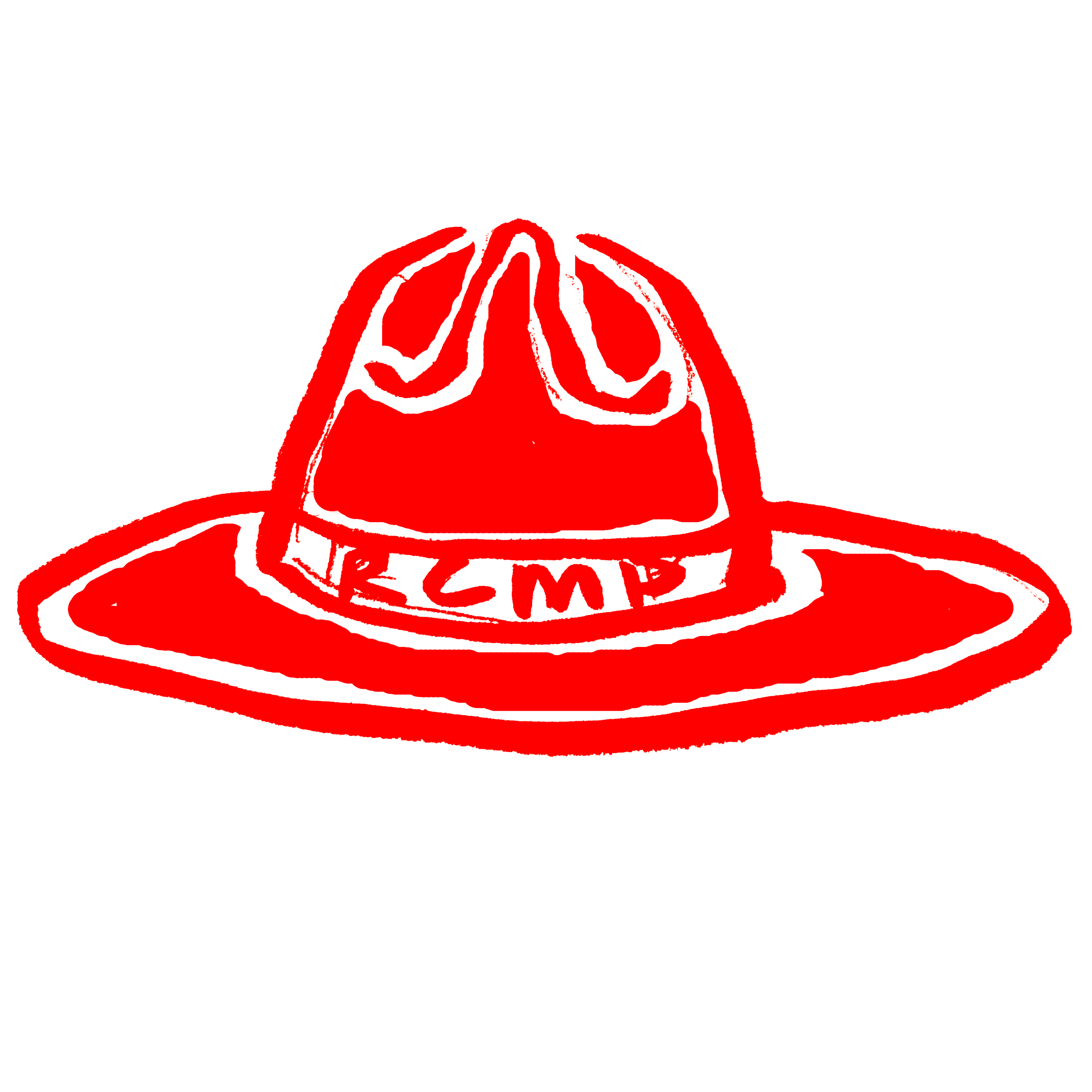Saba Quereshi looks at the modern effects of Canadian colonialism and how it is deeply rooted in Canada’s past
Editor’s Note: Avery Velez’s pronouns are incorrectly used in the print edition of this story. They have been corrected for the online version from “he/him”, to “they/them.” The Charlatan regrets and apologizes for the error.
In recent months, the controversial slogan ‘It’s okay to be white’ has been appearing in cities across Canada, and have even appeared in Ottawa.
This message made its way to Carleton’s campus, being graffitied along a tunnel wall during the fall semester.
Responses to the message were varied. Upon being made aware of the graffiti, Carleton University painted over it.
In a past Charlatan article, Carleton University Students’ Association president David Oladejo said it is unacceptable for anyone to vandalize campus property and target racialized students at Carleton.
“I know that this has been an issue in other campuses across Canada, and it’s unfortunate that this has reached our campus,” he said.

Others disagree. John Grabkowski, a student at Carleton said in an email, that the removal of the graffiti was “a blatant attack on free speech specifically targeting white people.”
“The ‘It’s okay to be white’ posters are just a sign of students frustration in an overly ‘PC’ (politically correct) world,” he said. “In today’s society, free speech is being suppressed in the name of not hurting people’s feelings while at the same time infringing on the rights of others.”
“This is a sad demonstration of how free speech is OK on campus as long as you have a left-leaning political ideology,” he added.
This isn’t the first time Carleton has dealt with a racially-charged incident. On Sept. 17, 2017, recruitment posters from anti-immigrant group called “Generation Identity” were found around campus.
Experts say that, while incidents like these seem far removed and out of place to the public, they are just overt expressions of Canada’s long history of difficult race relations.
Canada’s blind spot
Stephen Azzi, director of the graduate political management program at Carleton, said Canada is a multicultural society, and this should be a point of pride for Canadians. However, he said sometimes this pride is used to mask underlying issues that still exist in Canadian society.
“Sometimes, we are convinced of our goodness that we don’t see when we are doing bad, doing wrong,” he said. “Yes, Canada is a multicultural society and people from other countries are welcome here but there is racism towards visible minorities whether they were born abroad or born here, and I think we tend to overlook that when we spend too much time patting ourselves on the back for our tolerance.”
 “From the time of confederation, there was certainly an attitude of white supremacy, especially amongst the ruling class. John A. MacDonald–our first prime minister–talked about preserving the Aryan race,” said Azzi.
“From the time of confederation, there was certainly an attitude of white supremacy, especially amongst the ruling class. John A. MacDonald–our first prime minister–talked about preserving the Aryan race,” said Azzi.
“In the House of Commons when some Indigenous men were hanged after the the Northwest Rebellion, people looked to MacDonald to pardon them. He said that ‘they will hang so that the red man knows that the white man rules.’”
“There was very blatant racism—it was very much a society based on white supremacy.“
Continuing tensions between the Canadian government and Indigenous people were evident with the arrests on Jan. 15 of 14 Indigenous people by RCMP officers, who had set up a barricade in protest of their land being used for the construction of a pipeline.
The plight of the Wet’suwet’en captured national media attention, and sparked controversy.
“When you peel back the layers of the issues, you start to see the systemic problems we have in Canada,” Scott Macleod, chief of the Nipissing First Nations, said, “and how the Indigenous people are always the ones to bear the brunt.”
According to the Poverty Institute, a research group, one in four Indigenous people in Canada live in poverty.
Macleod said Indigenous people have been shut out of the modern economy for more than a century, which has lead to higher rates of poverty and a desperation amongst Indigenous people.
“When they have been marginalized and kept out of the economy, they are basically starving for opportunities. If you brought a starving man into McDonald’s, he’s going to eat junk food.” – Scott Macleod, Chief of the Nipissing First Nations
Past leading to modern-day tensions
In a 2018 report on the spread of right-wing extremism in Canada, researchers Barbara Perry and Ryan Scrivens said racial hatred is deeply rooted in societal systems.
According to a three-year study from 2012 and 2015 on the right-wing extremist movement in Canada (RWE), Perry and Scrivens found that there are four factors that enable racist attitudes and actions: permission to hate, history of racism, political climate of intolerance and weak law enforcement.
The first enabling factor,“permission to hate” focuses on the fact that many societies have a history with things such as colonialism and racism, which can make these ideas seem more acceptable in the broader culture.
Perry and Scrivens wrote that this “permission to hate” is most clearly directed at Indigenous peoples in Canada.
“Canada is itself a legacy of centuries of persecution of minorities.”
– Researchers Barbara Perry and Ryan Scrivens, “A Climate for Hate? An Exploration of the Right Wing Extremist Landscape in Canada”
Another key factor which Perry and Scrivens said was key in the growth of RWEs is that these groups are often met with little resistance from law enforcement. “Selective enforcement is evident in police failure to protect diverse communities from hate crime, in that police are thought to take less seriously the victimization of minority groups,” the report said.
Racism in policing is a well-documented problem in the U.S., but it is also a problem north of the border.
According to a 2015 Statistics Canada report, only three per cent of adults in Canada are Indigenous, yet they represent between 20 and 24 per cent of adult inmates in Canada’s jails and prisons.
Avery Velez, a volunteer with the Wet’suwet’en movement and of Mi’kamq heritage, said the group have developed specific strategies for trying to avoid increased police presence.
“Once we post things in advance the more of them show up, and the more [police] there are the more afraid the activists feels,” they said. “It just increases the tensions which makes it really difficult to have any successful action, they will also make weird perimeters around us to control where we walk and how we can get there.”
“The idea that they are there to protect us or the general citizens is absurd—they’re really there to control us and control the direction of our actions,” added Velez.
Solutions?
Experts seemed to agree on that education is key to combating intolerance and white supremacy.
This can come from multiple sources, said Azzi.
“The media has a role to play here, the education system has a role to play here, and I think individuals have a role to play confronting the stigma.”
“The next time your crazy uncle is at the dining table, rather than rolling your eyes, saying ‘hey, maybe all immigrants aren’t rapists and criminals’ is probably a good thing.” – Stephen Azzi, director of the political management graduate program at Carleton
Macleod said education of Canadian children has been lacking, and tends to focus on the history of European colonizers opposed to the Indigenous people that proceeded them.
“To a lot of Canadians, they were very ignorant of the fact that there was residential schools, up until five, 10 years ago,” he said. “Not because of them not wanting to see it, but because of the government never wanted to teach it.”
Macleod said this was also a problem for treaty rights and Indigenous issues in general.
Velez also said even though they are not one of the prominent organizers with the Wet’suwet’en support movement in Ottawa, there is an important role to play for them and others.
“It’s important to have the same people at the events over time, so you can really build the community, the relationships and the trust,” they said. “You need those relationships especially when you’re doing things such as sit-ins, because it lets you be more flexible.”
Kaedan Seburn, a second-year social work student at Carleton University who has also been involved with the movement, said it can be draining.
“These movements have been going on forever, and they will continue to be ongoing,” he said. “I hope we can reach enough people who understand what we’re doing and why we’re doing it, because at the end of the day, creating political change requires enough people understand the issues and are vocal enough in their support.”
Macleod said that the change must come from everyone engaging in the discussion on these issues.
“Until Canadians talk about it, uncomfortable as that discussion may be, we are never going to be able to move on together.”






